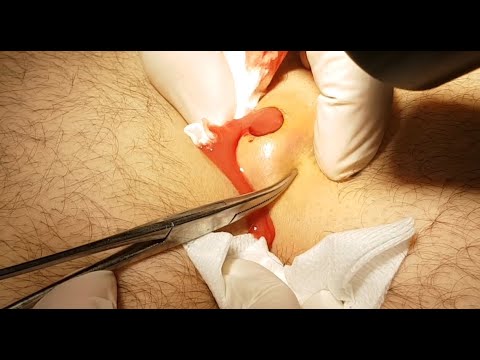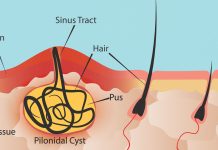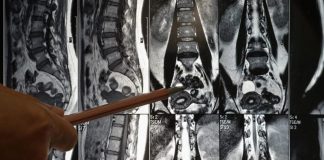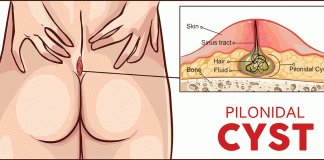This is a natural process that can occur when the cyst becomes infected and fluid accumulates. The fluid will eventually drain out on its own, although you may need to help it along a bit. You can do this by applying pressure to the area, using a hot compress, or taking a hot bath.
What is a pilonidal cyst?
A pilonidal cyst or pilonidal disease is an abnormal saclike structure in the skin. It usually happens in the crease between the buttocks, near the tailbone. It often contains hair and small pieces of skin. It can get infected and cause an abscess, which is a pocket of infected fluid (pus) with a thick wall around it.
How does it occur?
These cysts seem to be caused most often by ingrown hair. A hair grows back under the skin or skin grows closed over a hair. This might happen, for example, because of pressure or friction, like when you have been sitting or riding a bicycle for a long time. The ingrown hair irritates the skin and causes a cyst to form around the hair.
You may be more likely to have a pilonidal cyst if you were born with a little dimple in the skin between the buttocks. For reasons that are not well understood, the dimple can tend to get infected.
What are the symptoms of pilonidal disease?
There are a lot of things that can cause a pilonidal cyst:
- redness and swelling around your tailbone and just above the crease between your buttocks
- pus oozing from the swollen area
- tenderness when the swollen area is touched
- sometimes fever, weakness, or nausea
How is it diagnosed?
Your healthcare provider will ask about your symptoms and examine you for what you are feeling that may be related to pilonidal disease.
How is it treated?
If the pilonidal disease is infected, it usually needs to be treated by your healthcare provider. This treats the infection and gets rid of the pressure that causes pain. It can be done in your provider’s office. Even if the cyst is not infected, opening it and draining it is recommended to relieve pain and prevent infection.
The process for draining a pilonidal abscess is:
- The area of infection is numbed with a local anesthetic.
- Your provider uses a sharp knife to make a small cut into the abscess so that the pus in the abscess can drain out of it and hair and other debris can be removed.
- Your provider fills the abscess with sterile gauze.
A problem called chronic pilonidal sinus can happen after an abscess has been drained. A pilonidal sinus is a space under the skin that forms where the abscess used to be. The problem with the sinus is that it can lead to repeated infections. The sinus connects to the skin with one or more small openings. In some cases the sinus may heal and close by itself, but usually the sinus has to be cut out. The sinus area may be stitched shut after the sinus is removed or it may be left open to drain and heal from the inside out. Your provider will discuss your choices for treatment.
Is it good if my pilonidal cyst is draining?
If your pilonidal cyst is drainable and comes and goes on its own, you might be experiencing a benign condition. These cysts, which are also called pilonidal fistulas, are a result of pressure or friction on the affected area. Your body treats this hair as a foreign substance and treats it accordingly. This condition is also more common in people with hair on their buttocks and in people who spend long hours sitting.
When a pilonidal cyst first forms, incision and drainage are the preferred method of treatment. Incision and drainage involves cutting the cyst open, draining it, and packing the area with gauze. Under local anesthesia, this procedure can be performed by a healthcare provider and requires frequent changes in gauze. The drainage of pus and hair is necessary for the healing of the cyst. Then, marsupialization may be used. In this procedure, the healthcare provider removes the hair from the area surrounding the cyst, sews up the edges to form a pouch.
Your doctor may recommend a course of antibiotics, hot compresses, or topical treatment with depilatory creams. You may also be advised to consult a dermatologist if your pilonidal cyst has not yet gone away on its own. Depending on the severity of your pilonidal cyst, you may be able to cure it yourself with a home remedy, or you may need to seek medical assistance.
Will pilonidal cysts drain on their own?
The cause of pilonidal cysts is not fully understood. They may be congenital, originating from embryologic cells growing in the wrong place. They can also be caused by repeated trauma or small groups of hairs getting trapped in the skin’s pores. Sometimes, pilonidal cysts drain on their own. However, in some cases, it is necessary to drain the cyst. To do this, a small incision is made, and the affected area is numbed.
While pilonidal cysts do not require surgical treatment, they do require a doctor’s intervention. A hot compress may help remove the pus and allow the cyst to drain. Other treatments may include using a sitz bath or a warm compress. You may also want to consult your physician if your symptoms persist.
If you are experiencing a pilonidal cyst for the first time, a physician may perform an incision and drainage. This procedure involves cutting and draining the cyst, packing the area with gauze to keep it clean, and then stitching the area to form a pouch. This procedure is an outpatient procedure, and you don’t have to stay overnight. Depending on the size of the pilonidal cyst, you may receive local or general anesthesia.
What if a pilonidal cyst pops on its own?
Surgical removal of a pilonidal cyst is usually a last resort. This method involves removing the cyst and packing it with gauze, which must be changed regularly. The pilonidal cyst is usually treated as an outpatient procedure, and it does not require an overnight hospital stay. A doctor may use general or regional anesthesia, or you may only be required to receive local anesthesia.
Pilonidal cysts can be congenital or acquired, and the most effective treatment is to avoid popping the pimples or squeezing them. These treatments are unlikely to remove all of the cyst’s contents, leaving a scar. Additionally, popping pilonidal cysts will leave a scar and increase the risk of infection.
A pilonidal cyst begins beneath the skin on the sacrum, near the tailbone. It resembles a tiny pimple and often contains oil, hair, and dead skin cells. They may stay small or become large. The skin is typically red and inflamed, and you may notice a pus-filled cyst occasionally. Sometimes, pus may drain from the pilonidal cyst.
What does it mean if a pilonidal cyst is draining?
Pilonidal cysts can be caused by rubbing or injury, ingrown hair, or a combination of these factors. These growths can be painful and should be cleaned regularly with a gentle cleanser. People who sit for long times should avoid wearing tight clothing on the affected area. Some cysts can drain on their own and do not need treatment. However, in some cases, they need to be lanced to remove the cyst.
If the pilonidal cyst drains on its own, it’s benign. It is important to note that chronic pilonidal cysts can form in the sinus cavity underneath the skin. If the pilonidal cyst is too large to drain on its own, it may require surgical treatment. A surgeon may leave a wound open for packing or close the wound with sutures and a skin flap.
A pilonidal cyst is a sac filled with hair or skin debris trapped under the skin. They often form because of ingrown hair entwined underneath the skin. Often, they form near the tailbone or the cleft of the buttocks. Hair can penetrate the skin through friction with clothing and cause an infection. These sacs can become painful and drain pus occasionally.
Can a cyst drain on its own?
A pilonidal cyst can be congenital or acquired. A simple infection of a hair follicle can enlarge into a cyst, a condition known as pilonidal cystitis. If you notice a pilonidal cyst, seek medical attention right away. You may be suffering from a localized infection that can be cured by hot water soaks.
If the symptoms are not severe or go away after a couple of days, you may want to consider surgery to drain the pilonidal cyst. If surgery isn’t an option, the cyst may recur. In such a case, the patient will be given instructions on how to care for the wound. Even if the pilonidal cyst drains on its own, it is important to follow all instructions given by the healthcare provider.
Symptoms of pilonidal cysts can include a lump in the area near the tailbone. If left untreated, pilonidal cysts can develop into chronic conditions. If they do not drain, they can lead to a wide range of symptoms, from mild to severe. Treatment for pilonidal cysts may involve antibiotics or topical treatment with depilatory creams.
How long should a pilonidal cyst drain?
There are many things you can do to help it disappear. Taking hot water soaks or applying depilatory creams to the inflamed area may help. A hot water soak can also draw out the infection. If it drains on its own, you can avoid antibiotics and invasive procedures.
Pilonidal cyst surgery involves cutting the cyst open and draining the contents. The wound is covered with gauze to prevent infection and pain. However, you should be aware that you’ll be sore after surgery. Depending on the size and location of the cyst, you may be given local or general anesthesia.
A pilonidal cyst infection is an extremely painful condition. This condition is most common in men between the ages of puberty and forty. Left untreated, it can become chronic, resulting in pain and discomfort. Surgical removal of the cyst may be the only option if your symptoms are severe. The procedure is relatively inexpensive compared to other treatments.
Does a cyst leave a hole?
One of the most common questions that parents ask about pilonidal cysts is whether it will leave a hole after surgery. The answer to this question is yes. Usually, pilonidal cyst surgery leaves a hole in the affected area, but it’s important to understand that it doesn’t always happen. Sometimes, a pilonidal cyst is harmless and the hole will eventually heal by itself. If this happens, however, the hole will fill up and eventually heal itself. Depending on the size of the cyst, the surgeon may suggest other procedures or leave the hole open.
Pilonidal cysts are typically found in the top cleft of the buttocks. The location is often where the cheeks meet, and they may be covered with coarse hair. They occur more often in white men and are more common in the late teens and early 20s. They may also be painful. Treatment for pilonidal cysts may include surgery or non-surgical treatments.
How do I know if my pilonidal cyst is healing?
There are several ways to determine if your pilonidal cyst is healing. Follow your doctor’s wound care instructions and complete an antibiotic course. Pilonidal cyst treated are often recurrent. If they do recur, they may be cancerous. The recurrence rate varies from 13.8 percent to 32 percent. The recurrence rate is even higher for pilonidal cysts that are drained using an incision and drainage technique.
While pilonidal cysts are not life-threatening, if they’re left untreated they can be difficult to treat and can even become chronic. If you experience any of the above symptoms, seek medical attention as soon as possible. Discuss your symptoms openly with your healthcare provider. You might be suffering from a painful pilonidal cyst.
In some cases, your doctor may recommend a surgical procedure to drain the pilonidal cyst. The doctor will make a small incision in your skin to remove the pus from the abscess. A Gips procedure is another option. The doctor will make a small incision in your skin to drain the abscess. You may also be prescribed antibiotics to treat the underlying infection and remove ingrown hairs. It’s important to follow your doctor’s post-operative instructions carefully.
What is a pilonidal abscess and how is a pilonidal cyst diagnosed??
Once a pilonidal cyst is diagnosed by your doctor, they will start by giving you a full physical examination. Examiners will look for pilonidal cysts in the buttocks crease. Pilonidal cysts should be apparent. Your doctor may discover a pimple or cyst. Ingrown hairs induce pilonidal abscesses. Abscess on tailbone and buttocks. The infection creates a pus pocket. Painful. Doctors often open and drain abscesses.
Is a pilonidal cyst hereditary?
Having a family history of an infected pilonidal cyst is possible in some instances (you can inherit it from a family member). It’s possible that your family history will play a part in whether you get pilonidal cysts. For instance, if your family has a history of having coarse body hair, you might be predisposed to developing these cysts.
Is a pilonidal cyst contagious?
A pilonidal cyst is a non-contagious skin condition – you can’t spread it (just like a pimple). Currently, many researchers believe that pilonidal cysts are caused by ingrown hairs or caused by skin irritation.
Conclusion
Your doctor will perform a comprehensive physical exam after diagnosing a pilonidal cyst. Examiners check for buttocks creases and pilonidal cysts. Clearly visible pilonidal disease. A pimple or cyst may be found. Ingrown hairs cause piles. Tailbone and buttock abscesses. Doctors drain abscesses. Because of this, the walls of the pilonidal sinus may be subjected to a significant amount of pressure. As a direct consequence of this, you can experience an increase in both pain and inflammation. You can always try applying hair removal cream, asking for advances from rectal surgeons, some pain medicine or other treatment methods.
Anyone can get a pilonidal cyst. However, some are more likely, such as:
- Guys (men are three to four times more likely to be diagnosed with a pilonidal cyst than women)
- Puberty-to-40-year-olds (the average age is between 20 and 35).
- Sit-all-day workers (like truck drivers and office workers).
- obese (ranging from overweight to obese).
- Hairy people (this can run in your family).
- Tight-clothed (this can worsen skin conditions).
- Hereditary pilonidal cyst (you can inherit it from a family member). If rough body hair runs in your family, you may have pilonidal cysts. Infected pilonidal cysts can be treated with laser hair removal, antibiotic cream, surgery, or a therapy plan.
- A pilonidal cyst isn’t communicable (just like a pimple). Ingrown hairs or skin irritation are believed to induce pilonidal cysts.
Additional Reading – Can Pilonidal Cysts Cause Back Pain

Doctor Osvaldo Pepa, Neurosurgery Service Physician at Hospital San Martin, La Plata, Argentina. I graduated last November 16, 1984 with a Medical Degree at the Universidad Nacional de La Plata. The Medical Board of La Plata, District 1, licensed me as a Neurosurgeon in 1990. I hold a Provincial and National License and an active member of the Neurosurgery Society of La Plata, World Ozone Therapy Federation, and Inter American Society of Minimally Invasive Surgery.




